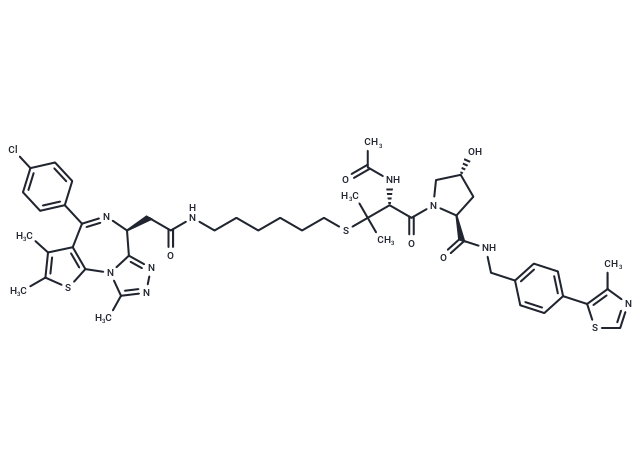Shopping Cart
Remove All Your shopping cart is currently empty
Your shopping cart is currently empty
BRD4 degrader AT1 is a highly selective Brd4 degrader based on PROTAC technology, with a Kd of 44 nM for Brd4BD2 in cells.

| Pack Size | Price | USA Warehouse | Global Warehouse | Quantity |
|---|---|---|---|---|
| 5 mg | $1,590 | 35 days | 35 days |
| Description | BRD4 degrader AT1 is a highly selective Brd4 degrader based on PROTAC technology, with a Kd of 44 nM for Brd4BD2 in cells. |
| Targets&IC50 | BRD2 BD2:94 nM (Kd), BRD2 BD1 KEA:35 nM (Kd), BRD2 BD1:111 nM (Kd), BRD3 BD2:39 nM (Kd), BRD4 BD1:75 nM (Kd), BRD4 BD2:44 nM (Kd), BRD3 BD1:35 nM (Kd), BRD4 BD2QVK:38.8 nM (Kd) |
| In vitro | BRD4 degrader AT1 is a highly selective Brd4 degrader, exhibiting a Kd of 44 nM for Brd4BD2 in cells, and shows Kds of 38.8 nM for mutant Brd4BD2 (QVK), 111 ± 14 nM for Brd2BD1, 94 ± 9 nM for Brd2BD2, 35 ± 3 nM for Brd3BD1, 39 ± 8 nM for Brd3BD2, 75 ± 23 nM for Brd4BD1, and 35 ± 4 nM for mutant Brd2BD1 (KEA). At concentrations of 1-3 μM, BRD4 degrader AT1 induces significant Brd4-selective depletion while exhibiting minimal activity against Brd2 and Brd3[1]. |
| Molecular Weight | 972.68 |
| Formula | C48H58ClN9O5S3 |
| Cas No. | 2098836-45-2 |
| Relative Density. | 1.39 g/cm3 (Predicted) |
| Storage | Powder: -20°C for 3 years | In solvent: -80°C for 1 year | Shipping with blue ice/Shipping at ambient temperature. |
| Size | Quantity | Unit Price | Amount | Operation |
|---|

Copyright © 2015-2025 TargetMol Chemicals Inc. All Rights Reserved.